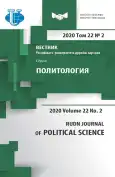«Золотой щит» Китая: политика управления мнемоническими интернет-практиками
- Авторы: Подшибякина Т.А.1
-
Учреждения:
- Южный федеральный университет
- Выпуск: Том 22, № 2 (2020)
- Страницы: 194-204
- Раздел: ГЛОБАЛЬНОЕ ДИСКУРСИВНОЕ ПРОТИВОБОРСТВО
- URL: https://journal-vniispk.ru/2313-1438/article/view/322156
- DOI: https://doi.org/10.22363/2313-1438-2020-22-2-194-204
- ID: 322156
Цитировать
Полный текст
Аннотация
Актуализация прошлого является естественным для общества проявлением потребности в рефлексии исторической памяти, она же подталкивает элиты к поиску новых форм «ментального контроля» над общественным сознанием. Исследование посвящено проблеме сохранения исторической памяти в условиях цензуры в сети Интернет. Цель заключается в выявлении символических эффектов исторической памяти, возникающих в результате нарративной репрезентации истории и когнитивных мнемонических практик сетевых медиа и сетевых интернет-сообществ в условиях цензуры. Результатом исследования стала концептуализация понятия «когнитивные мнемонические интернет-практики», их типологизация в соответствии с видами когнитивной цензуры сетевых медиа и описание их символических эффектов. Концептуализировать понятие «когнитивные мнемонические интернет-практики» и обосновать выводы позволил анализ case study современных китайских сетевых медиа.
Об авторах
Татьяна Александровна Подшибякина
Южный федеральный университет
Автор, ответственный за переписку.
Email: tan5@bk.ru
кандидат политических наук, доцент кафедры теоретической и прикладной политологии Института философии и социально-политических наук
Российская Федерация, 344006, Ростов-на-Дону, ул. Большая Садовая, 105/42Список литературы
- Leksyutina Y.V. American-Chinese dialogue on the development and government regulation of the global Internet. Bulletin of St. Petersburg University. Series 6. Political science. International relationships. 2011; 2: 67–76. (In Russ.).
- King G., Pan J., Roberts M.E. How the Chinese government fabricates social media posts for strategic distraction, not engaged argument. American political science review. 2017; 111 (3): 484–501.
- Cheng Y., Lee C.J. Online crisis communication in a post-truth Chinese society: Evidence from interdisciplinary literature. Public Relations Review. 2019. DOI: https://doi.org/ 10.1016/j.pubrev.2019.101826
- Leksyutina Y.V. Policy of the Chinese leadership in matters of control and regulation of the Internet. Society and State in China. 2015; 17–1: 28–37. (In Russ.).
- Semenova N.K. Non-governmental organizations of the PRC are the sprouts of democracy. Xinghai revolution and Republican China – the century of revolutions, evolution and modernization. Digest of articles. M.: Institute of Oriental Studies, Russian Academy of Sciences, 2013: 209–222. (In Russ.).
- Ganshin V.G. The role of the Internet in the process of forming civil society in China. Problems of the Far East. 2010; 4: 84–92. (In Russ.).
- Han E.L. Journalism and mnemonic practices in Chinese social media: Remembering catastrophic events on Weibo. Memory Studies. 2017. DOI: https://doi.org/10.1177/ 1750698017714833
- Wang Y. Contesting the past on the Chinese Internet: Han-centrism and mnemonic practices. Memory Studies. 2019. DOI: https://doi.org/10.1177/1750698019875996
- Gustafsson K. Chinese collective memory on the Internet: Remembering the Great Famine in online encyclopaedias. Memory Studies. 2019; 12 (2): 184–197.
- Wu X. Discursive strategies of resistance on Weibo: A case study of the 2015 Tianjin explosions in China. Discourse, Context & Media. 2018; 26: 64–73.
- Li H.S. Spoof Videos: Entertainment and Alternative Memory in China. Entertainment Values. Palgrave Macmillan, London, 2017: 179–194.
- Li H.S. Narrative dissidence, spoof videos and alternative memory in China. International Journal of Cultural Studies. 2016; 19 (5): 501–517.
- Zhao H., Liu J. Social Media and Collective Remembrance. The debate over China’s Great Famine on weibo. China Perspectives. 2015; 2015 (2015/1): 41–48.
- Liu J. Who Speaks for the Past? Social Media, Social Memory, and the Production of Historical Knowledge in Contemporary China. International Journal of Communication. 2018; 12: 21.
- Cao X. Censorship and Everyday Forms of Resistance in Chinese Cyberspace. ResearchSpace@ Auckland 2015. URL: https://researchspace.auckland.ac.nz/handle/ 2292/28131. Accessed: 29.12.2020.
- Giese K. Speaker’s corner or virtual panopticon: Discursive construction of Chinese identities online. Cyber China. Palgrave Macmillan, New York, 2004: 19–36.
- Mengin F. Cyber China: Reshaping National Identities in the Ages of Information. New York: Palgrave Macmillan, 2004: 260.
- Cui D., Wu F. Moral goodness and social orderliness: An analysis of the official media discourse about Internet governance in China. Telecommunications Policy. 2016; 40 (2–3): 265–276.
- Nordin A., Richaud L. Subverting official language and discourse in China? Type river crab for harmony. China Information. 2014; 28 (1): 47–67. doi: 10.1177/0920203X14524687
- Tang L., Yang P. Symbolic power and the internet: The power of a ‘horse.’ Media, Culture & Society. 2011; 33 (5): 675–691. DOI: https://doi.org/10.1177/0163443711404462
- Meng B. From Steamed Bun to Grass Mud Horse: E Gao as alternative political discourse on the Chinese Internet. Global Media and Communication. 2011; 7 (1): 33–51. DOI: https://doi.org/10.1177/1742766510397938
- Schmidt L., de Kloet J. Bricolage: Role of Media. The International Encyclopedia of Media Effects. 2017: 1–9.
- Yang F. Rethinking China’s Internet censorship: The practice of recoding and the politics of visibility. New Media & Society. 2016; 18 (7): 1364–1381. DOI: https://doi.org/10.1177/ 1461444814555951
Дополнительные файлы









